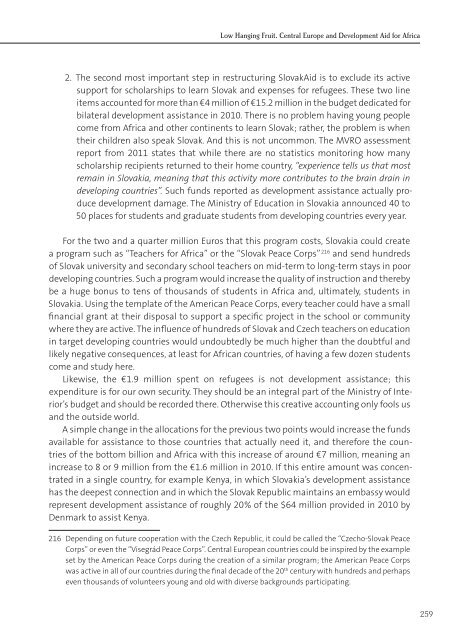Giant_and_Dwarf-FIN
Giant_and_Dwarf-FIN
Giant_and_Dwarf-FIN
You also want an ePaper? Increase the reach of your titles
YUMPU automatically turns print PDFs into web optimized ePapers that Google loves.
Low Hanging Fruit. Central Europe <strong>and</strong> Development Aid for Africa2. The second most important step in restructuring SlovakAid is to exclude its activesupport for scholarships to learn Slovak <strong>and</strong> expenses for refugees. These two lineitems accounted for more than €4 million of €15.2 million in the budget dedicated forbilateral development assistance in 2010. There is no problem having young peoplecome from Africa <strong>and</strong> other continents to learn Slovak; rather, the problem is whentheir children also speak Slovak. And this is not uncommon. The MVRO assessmentreport from 2011 states that while there are no statistics monitoring how manyscholarship recipients returned to their home country, “experience tells us that mostremain in Slovakia, meaning that this activity more contributes to the brain drain indeveloping countries”. Such funds reported as development assistance actually producedevelopment damage. The Ministry of Education in Slovakia announced 40 to50 places for students <strong>and</strong> graduate students from developing countries every year.For the two <strong>and</strong> a quarter million Euros that this program costs, Slovakia could createa program such as “Teachers for Africa” or the “Slovak Peace Corps” 216 <strong>and</strong> send hundredsof Slovak university <strong>and</strong> secondary school teachers on mid-term to long-term stays in poordeveloping countries. Such a program would increase the quality of instruction <strong>and</strong> therebybe a huge bonus to tens of thous<strong>and</strong>s of students in Africa <strong>and</strong>, ultimately, students inSlovakia. Using the template of the American Peace Corps, every teacher could have a smallfinancial grant at their disposal to support a specific project in the school or communitywhere they are active. The influence of hundreds of Slovak <strong>and</strong> Czech teachers on educationin target developing countries would undoubtedly be much higher than the doubtful <strong>and</strong>likely negative consequences, at least for African countries, of having a few dozen studentscome <strong>and</strong> study here.Likewise, the €1.9 million spent on refugees is not development assistance; thisexpenditure is for our own security. They should be an integral part of the Ministry of Interior’sbudget <strong>and</strong> should be recorded there. Otherwise this creative accounting only fools us<strong>and</strong> the outside world.A simple change in the allocations for the previous two points would increase the fundsavailable for assistance to those countries that actually need it, <strong>and</strong> therefore the countriesof the bottom billion <strong>and</strong> Africa with this increase of around €7 million, meaning anincrease to 8 or 9 million from the €1.6 million in 2010. If this entire amount was concentratedin a single country, for example Kenya, in which Slovakia’s development assistancehas the deepest connection <strong>and</strong> in which the Slovak Republic maintains an embassy wouldrepresent development assistance of roughly 20 % of the $64 million provided in 2010 byDenmark to assist Kenya.216 Depending on future cooperation with the Czech Republic, it could be called the “Czecho-Slovak PeaceCorps” or even the “Visegrád Peace Corps”. Central European countries could be inspired by the exampleset by the American Peace Corps during the creation of a similar program; the American Peace Corpswas active in all of our countries during the final decade of the 20 th century with hundreds <strong>and</strong> perhapseven thous<strong>and</strong>s of volunteers young <strong>and</strong> old with diverse backgrounds participating.259


